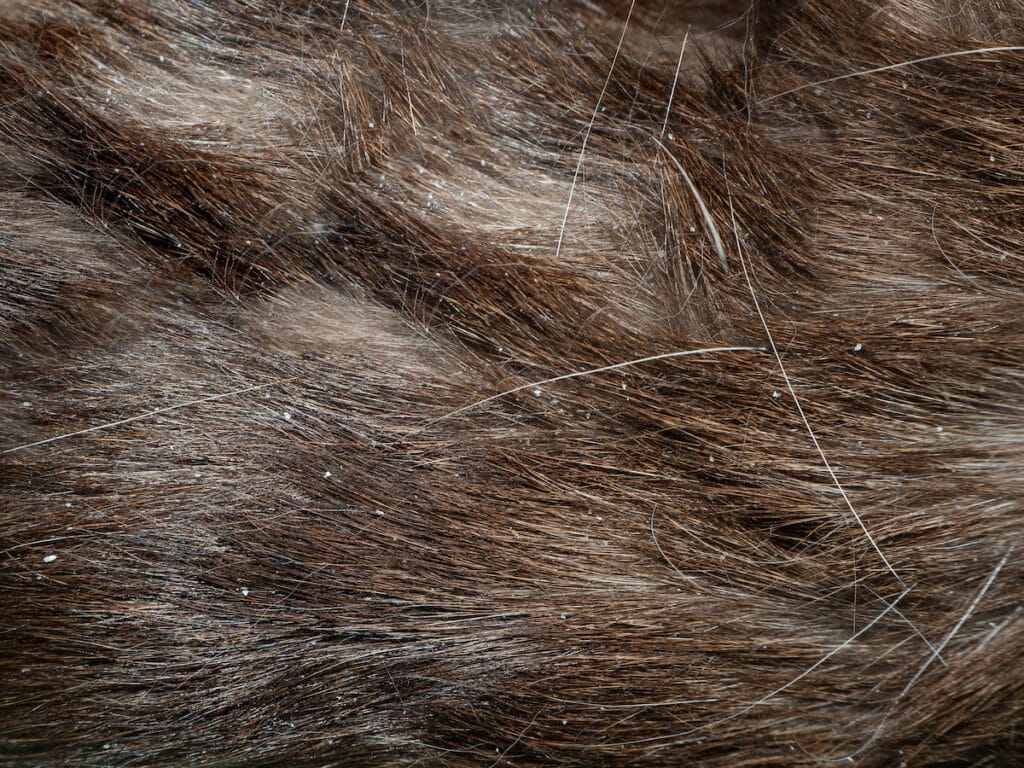Having a cat can be a good thing, but sometimes they can get dandruff. Dandruff is caused by bacteria, and can lead to a number of unpleasant symptoms. Luckily, there are things you can do to help your cat get rid of dandruff.
Symptoms
Symptoms of cat dandruff include a flaky coat and irritated skin. This may be a sign of an underlying health issue. You should consult with a veterinarian.
It’s important to determine the underlying cause of the problem. This is the first step in treating cat dandruff. You may need to make changes in your pet’s routine. For example, you may want to feed your cat a moisturizing formula or apply a cat-safe moisturizer to your cat’s coat.
You may also need to check your cat’s weight. Cats that are overweight are more likely to have flaky skin. The best way to avoid dandruff is to feed them a healthy, balanced diet.
It’s also important to groom your cat regularly. While you don’t want to over-groom, you do need to brush your cat’s coat regularly. If your cat is obese, it may be difficult for you to reach its fur.
If your cat has dandruff, you may want to consider a topical spray, such as Thrive Silver Shield, which has anti-microbial properties.

Causes
dandruff in cats is a common problem. It can cause skin irritation, hair loss, and redness. This condition can be caused by an allergic reaction to a food or an underlying skin disorder. If your cat has dandruff, take it to a veterinarian. Depending on the cause of the dandruff, treatment may involve changing your pet’s diet.
Dry air can also cause cat dandruff. Your cat’s skin is very sensitive. It needs moisture to stay nourished. You can add a humidifier to your home to help improve your cat’s health.
Dry air can also lead to skin irritation. If your cat has flaking skin, it could be a sign of a parasitic infestation. Fleas, mites, and lice are common ectoparasites. If your cat is suffering from any of these skin conditions, your vet may prescribe antibiotics.
Getting your cat a regular brushing schedule can also help prevent dandruff. By brushing your cat, you will remove the dead skin cells and move natural oils to the fur.
Treatment
Getting rid of cat dandruff isn’t as difficult as you might think. Whether you’re a new or seasoned cat owner, there are a few simple steps you can take to help you manage dandruff. These tips can be used as a preventive measure as well as to treat the symptoms.
Dandruff in cats is caused by a combination of factors. These factors can include poor diet, an overheated environment, environmental contaminants, or even an unbalanced thyroid gland. A veterinarian can identify the underlying cause and prescribe a treatment for it.
The first thing you should do is make sure your cat is getting the nutrients it needs to stay healthy. The right food will boost moisture levels and help your cat maintain a healthy coat. Alternatively, you can supplement your cat’s diet with a fish oil supplement, which will provide omega-3 fatty acids.
A good bath will also do your cat a lot of good. The process will help to loosen flakes from your cat’s coat. You should also be sure to wash the areas around your cat’s eyes and ears. You can also apply a moisturizer or conditioner to help moisturize your pet’s skin.
Prevention
Taking care of your cat’s skin is very important. There are several different factors that can cause your cat’s skin to become dry. This can lead to cat dandruff. The first step in prevention is to determine the underlying cause.
The causes of cat dandruff can vary from parasites to allergies. Some cats may even have a nutritional deficiency.
The best way to determine the cause of your cat’s dandruff is to speak to your veterinarian. The vet can diagnose the condition and recommend a treatment plan. In addition, he or she can recommend the best diet for your cat.
Another common reason for dandruff in cats is a fungal infection. This can be treated with antibiotics.
In order to prevent dandruff in cats, the most important thing you can do is provide your cat with a high-quality diet. Cats need plenty of healthy fats and fatty acids. They also need to get enough water in order to stay hydrated.













